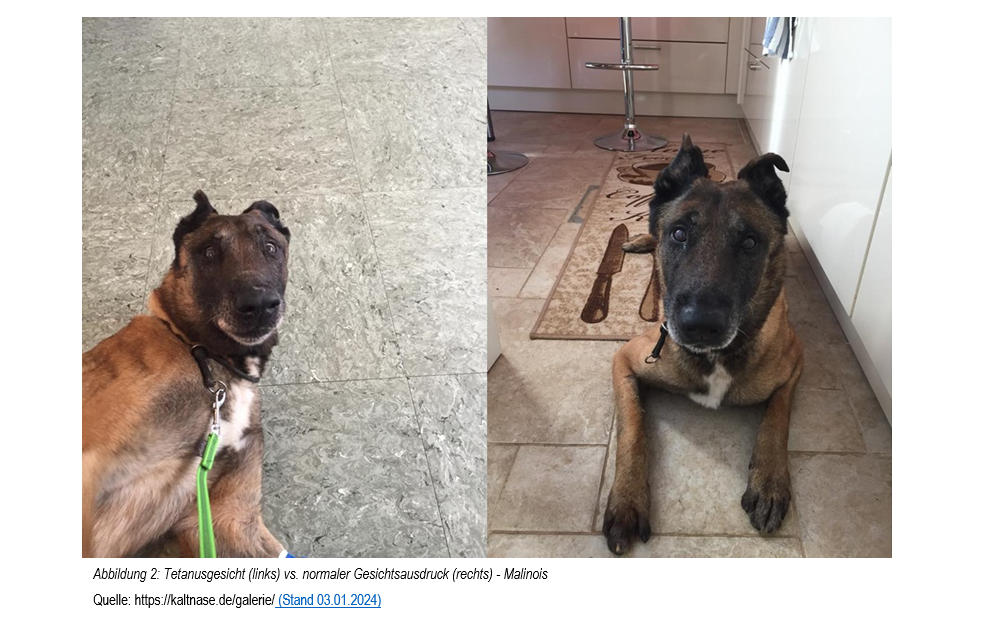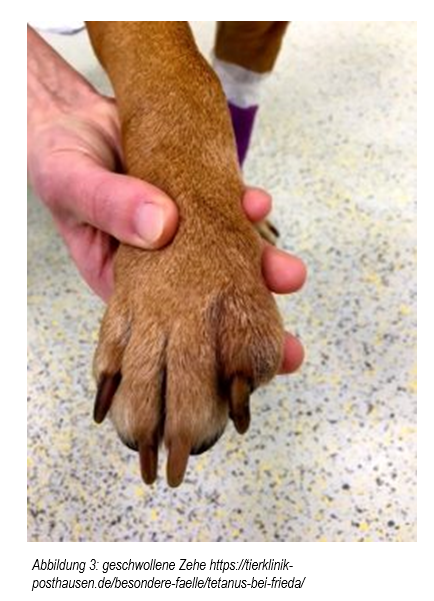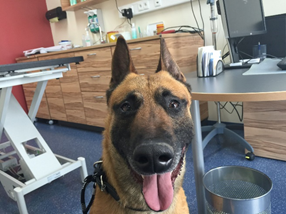Tetanus (lockjaw)
18.01.2024 10:12by Lisa Ley, Dr. Sue Chandraratne und Astrid Hübner
Translated by Patricia Pehrsson
Tetanus, also known as lockjaw, is a bacterial infectious disease that affects the nervous system. The disease is caused by the bacterium Clostridium Tetani, which typically enters the body through a wounds The symptoms of tetanus can vary widely and depend on the severity of the infection.
Tetanus is a very rare, non-contagious bacterial disease in dogs caused by Clostridium Tetani. If not treated promptly, the disease can be fatal.
Humans or horses are much more susceptible to tetanus than dogs. In comparison, a dog needs 600 times the amount of toxin produced by the bacteria to trigger clinical changes similar to those in humans. Nevertheless, dogs can still suffer from the disease, often due to simple injuries, including from nails, a piece of shattered glass, a little stick. The bacteria can enter through small wounds caused by cracked paw pads, abrasions, a torn claw, gum wounds, or a broken tooth.
Even small wounds can serve as entry point for the bacteria's spores. In some cases it is even difficult to identify the wound following onset of the disease. Clostridium Tetani is present in nearly any grounds. It also can be found in everywhere in the soil but can also be found in horse dung or manure. The bacteria are resistant.
After entering through wounds, the bacteria multiply in oxygen-poor conditions (such as wound pockets) and produce toxins that are transmitted along the nerves to the spinal cord. Tetanospasmin is the most important toxin produced by Clostridium tetani, acting directly neurotoxic (damaging the nervous system).
This leads to dramatic overstimulation of the muscles with tonic contractions and a typical facial expression (two hallmark symptoms of tetanus). The incubation period is five to nine days.
Another symptom of tetanus is increased sensitivity to light, also known as Photophobia. This symptom occurs due to the effects of the toxin on the nervous system. The toxin affects the function of nerves responsible for controlling eye muscles, resulting in heightened sensitivity to light.
Initially, it is difficult to distinguish tetanus from other infectious diseases. Symptoms are flu-like, including reduced general well-being, nervousness, sensitivity to noise, or even symptoms resembling poisoning. However, suddenly occurring muscle spasms are an initial indication of a tetanus infection.
As the disease progresses, the dog will show a stiff or unsteady gait, cramping extensor muscles, or cramps while standing. The respiratory muscles, esophagus and larynx, may also be affected by cramps, posing a risk of suffocation. Affected dogs usually require artificial nutrition through a stomach tube and infusion for an extended period of time.
Another symptom that might help doctors or veterinarians in pointing out the onset of a Tetanus infection is the so-called tetanus face. The facial expression of the dog is comparable to a clenched grin. The dog's gaze becomes fixed, and the third eyelid protrudes.

Picture 1: Tetanus face (on the left) vs. normal facial expression (on the right)

Picture 2: Tetanus face (on the left) vs normal facial expression (on the right) – Malinois
Prophylaxis
At the moment, no approved vaccine for dogs exists. Vaccines exists for other animals. A veterinarian can decide to use it in the course of a reassignment. However, due to possible side effects this cannot be recommended without While there are vaccines for other animal species that could be used through a process called reassignment, this can only be recommended partly.
The key to tetanus prevention in dogs lies in proper wound care. Any wounds should be promptly cleaned, disinfected, and dressed.
People who have had tetanus do not develop immunity against it. This means they can become infected with tetanus again.
Case Study Katrin Stenzel – Garonne (Gaja) vom Nilpferdhof - Malinois
In April 2023, Gaja’s owner noticed a swollen ankle on her front leg. The owner Katrin didn’t think much of it as Gaja had been playing a lot the previous day. She cooled the ankle. The swelling went down significantly by day two. Katrin didn’t see an injury except that one toe was slightly swollen. With Gaja improving, Katrin was reliefed and thought things were on a a good way.

The next day, Gaja had a strange look to her; her gaze seemed empty. Katrin checked for a foreign object in her eye because the third eyelid was protruding. She then took Gaja to the vet and explained "There's something strange about her gaze!" The veterinarian responded immediately, "It’s Tetanus!" The veterinarian who had seen various tetanus cases before, immediately diagnosed Gaja. This saved her life.
The veterinarians presented Katrin with two options: either send the dog to the University Clinic Hannover for six weeks, or treatment with the animal hospital Katrin was at where Gaja would live at home. Katrin decided to keep Gaja at home and go through it together with her dog.
They immediately tried to locate the wound of source which had to be the foot. Any swollen tissue was removed from it. Often, the affected toe or other parts need to be amputated to remove the wound of entrance. No one commented on Gaja's prognosis at that time or informed Kathrin about any long term effects or when she would know that Gaja was safe.
Katrin endured weeks of of alternating hope and anxiety. Gaja received two different antibiotics: Penicillin, to kill the bacteria and stop toxin production. However, antibiotics do not affect the toxin produced to this point in time which can cause severe muscle spasms. The verinarians quickly obtained tetanus serum from a horse clinic which helps to neutralize the toxin.
Gaja had to spend weeks in the dark because any stress, light, or noise can worsen symptoms. She showed strong reactions to only minor noises which got her in an agitated state of mind. Katrin kept her in isolation on the second floor. Away from other dogs and in complete darkness. Over the following days, her condition even worsened; her face contorted completely, her ears were stiff, and she showed the grin typical for Tetanus. Katrin took Gaja out only when it was dark. If she had to get outside during the day, she placed a tower over her head (3 times a day for a maximum of 3 minutes).
Gaja didn’t improve. Her muscles kept cramping. The veterinarian prescribed a muscle relaxant and Gaja received both Ortoton and Diazepam 3 times a day. The vet made home visits to spare Gaja from unnecessary contact with light. Gaja received a lot of fluid through canned food with water and regular temperature checks. Her breathing was observed on a regular basis. Unlike many other cases, Gaja could always walk and eat, and her breathing was not affected; probably due to an early start of therapy.
Only after two weeks, the symptoms improved slightly and Katrin decided to take Gaja downstairs – also in the dark. However, Gaja's condition worsened immediately. Katrin isolated Gaja and resumed without contact and affection. Katrin felt guilty that she had taken Gaja downstairs and Gaja stayed in the dark for another 2 weeks.
Starting from week 3, the veterinarian decided to taper down the medication while Gaja showed continuous improvement. After 4 weeks of darkness, Gaja's life slowly resumed her normal life. It took her 6 weeks to resume most of her regular life.
Katrin remembers, "Those were tough times, but we got through it together. If my veterinarian hadn't recognized Tetanus as quick as he did, my dog wouldn't be with me today." Today, Gaja is an active sport dog without any restrictions.
Case Study 2 – Florian Knabl – Conan vom Clan der Wölfe - Malinois
Conan was 1.5 years old when Florian noticed something was wrong during training. After calling him into the front sit, Conan didn’t run straight at him. Later, he didn’t pick up the dumbbell but bit in the air instead. When this happened, Florian stopped training to take a walk with Conan to check on him. He offered him some treats but Conan didn’t take them from the hand but rather seemed to try to take them from a shadow next to Florian. Florian noticed that Conan's eyes seemed to turn inwards. His cheeks also felt oddly stiff.
It was a holiday and Florian decided to take Conan to an emergency clinic. The attending doctor suspected an inflammation of the facial muscles with an effect on the eyes. She prescribed antibiotics but offered Florian to wait for a bit because the chief doctor was to stop by later.
A few hours later the chief doctor walked in, took a look at Conan and immediately diagnosed Tetanus due to the typical facial expression.

Florian was to take Conan home and observe the progression until the next day. Conan spent the night in a dark, quiet room. The following day, Conan's condition had already worsened significantly and Florian took him back to the animal hospital, where he was administered a small dosis of tetanus antitoxin for horses to see if he would develop an allergic reaction or could tolerate the medication.
The veterinarians examined Conan from head to paw for any injuries and only found a small red spot on one toe, equivalent to a human's index finger. This made sense. Bacteria could have entered through a small wound which immediately closed up. Ideal conditions for the multiplication of the bacterium: a low-oxygen environment and a small wound that doesn't cleanse itself through bleeding and promptly closes up.
The veterinarians amputated the toe completely. Florian prepared a room in the basement for Conan to stay in complete darkness.
However, Conan's condition worsened every day for the next two weeks. Florian received a lot of tips from friends who also had experience with Tetanus in dogs. It was a friend who suggested that symptoms can be alleviated with muscle relaxants. The treating veterinarians agreed.
Conan could always walk, although his movements were stiff like a robot’s movements. At the peak of the illness, he couldn’t turn at all and didn’t manage to get around a corner. Florian had to feed him porridge and pills through a syringe and barely managed to open Conan’s mouth sufficiently to do so.
During the last three days before finally improving, Conan couldn't drink on his own, his breathing was labored, and he was panting severely. The veterinarians injected water under his skin on a daily basis to keep him hydrated.
The long-awaited improvement began after what felt like two endless weeks. Florian noticed such improvement in Conan’s eyes. His eyes finally relaxed a bit and his gaze became clear again. From that point on, Conan improved by the day.
Approximately 8 weeks following the amputation and initial treatment, Conan was back in reasonably good shape.
3.5 years after the tetanus infection, Conan became the FMBB World Champion in IGP for the first time and reclaimed the title the following year. His success story should inspire anyone affected by this disease to confront it and not give up hope.
We express our heartfelt thanks to Katrin Stenzel and Dr. Florian Knabl for sharing their experiences. We hope that these two case studies may help recognizing and identifying early symptoms in affected dogs more quickly, ultimately saving more dogs from death due to tetanus.


Quellen:
https://modern-dogs.de/gesundheit/tetanus-beim-hund/
https://tierklinik-posthausen.de/besonde...nus-bei-frieda/
Leitlinie zur Impfung von Pferden | StIKo Vet am FLI | Stand 01.03.2023
https://www.msdmanuals.com/de-de/heim/in...kterien/tetanus
https://www.tk.de/techniker/gesundheit-u...22222?tkcm=aaus
https://kaltnase.de (abgerufen 02.01.2024)
DTBl_05_2018_Pharmakovigilanz.pdf (abgerufen 04.01.2024)
Informationen zu diesem Artikel
-
Erstellt von:
Astrid Hübner
Kategorie: English language articles
18.01.2024 10:12:00 Uhr
zuletzt bearbeitet: 18.01.2024 10:31 - Keine Kommentare
Kommentare
Der Captcha wurde falsch eingeben.
Sie haben zu viele Links in Ihrem Beitrag. Maximal dürfen Links gesetzt werden.
Sie haben zu viele Bilder in Ihrem Beitrag. Maximal dürfen Bilder verwendet werden.
Sie haben zu viele animierte Bilder in Ihrem Beitrag. Maximal dürfen animierte Bilder verwendet werden.
Ein in Ihrem Beitrag verwendetes Bild überschreitet die zulässige Breite, die vom Administrator des Forums festgelegt wurde. Die maximal erlaubte Breite sind Pixel.
Ein in Ihrem Beitrag verwendetes Bild überschreitet die zulässige Höhe, die vom Administrator des Forums festgelegt wurde. Die maximal erlaubte Höhe sind Pixel.
Der eingegebene Text ist zu lang (maximal 65.500 Zeichen).
Sie dürfen erst in Tagen Links zu externen Webseiten posten.
Sie dürfen erst nach Beiträgen Links zu externen Webseiten posten
Bitte lösen Sie das Captcha, um auch als Gast Links in diesem Forum zu posten.
Gäste können leider keine Links zu externen Seiten posten.
Bitte entfernen Sie folgende Links, um den Beitrag zu speichern:
